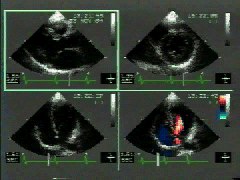

Video of Echocardiography (1812k)


Video of Echocardiography (1812k)
Medical scientists can use sound waves to see inside the body. Pulses of sound are transmitted into the body and the resulting echoes are recorded. One common use of this technology is to picture the fetus inside the mother's womb. Another use is to picture the heart's size, shape, and movement.
Echocardiography is the process of mapping the heart through echoes. The pulses are sent into the chest and the high-frequency sound waves bounce off of the heart's walls and valves. The returning echoes are electronically plotted to produce a picture of the heart called an echocardiogram.
The procedure is safe and relatively comfortable for the patient. However, sometimes an echocardiogram doesn't provide enough information and an invasive procedure may be necessary.
What is an echo?
An echo uses sound waves to form a picture of the heart valves and heart muscle. The echo machine sends sound waves to a transducer (a sound sensitive instrument) that is placed on the chest. The sound waves are reflected by the heart walls (muscle) and heart valves, back to the transducer, which changes the sound into a picture.
An echo provides information about heart chamber size, wall motion, valve movements, and structural changes in and around the heart.
There is no special preparation for this test. This test is usually done in the Echo Lab, but may be done in a clinic, or in the patient's room.
In the Echo Lab
You will be asked to remove clothing above the waist. EKG patches will be placed on your chest. You will be lying on your back or left side. A doctor or technician will apply gel, which feels cold, to your chest and a transducer will be placed over the heart area. Heart structures will be examined by changing the direction of the transducer. The sound waves cause no discomfort. You may hear a "whooshing" sound, timed with your heart beat. This is the blood movement near the transducer. An EKG will be recording the electrical activity of your heart which will help the doctor interpret your test.
When the test is completed the gel can be wiped off easily.
Considerations
An echo takes about 45 minutes.
The first results are available right after the test. After further review, the final results will be sent to your doctor.
Do you have any questions? Feel free to ask your doctor, a nurse, or the Echo Lab staff.
See related Patient Textbooks about Internal Medicine.
See related Patient Topics Cardiology, Diagnostic Imaging, Heart and Circulation, Heart Diseases--General, Internal Medicine, Procedures and Therapies or Seniors' Health.
See related Provider Textbooks about Internal Medicine.
See related Provider Topics Cardiology, Diagnostic Imaging, Heart and Circulation, Heart Diseases--General, Internal Medicine, Procedures and Therapies or Seniors' Health.
Virtual Hospital Home | Virtual Children's Hospital Home | Site Map | Mirror Sites | Search
Provider Health Topics A-Z | Provider Textbooks | Patient Health Topics A-Z | Patient Textbooks